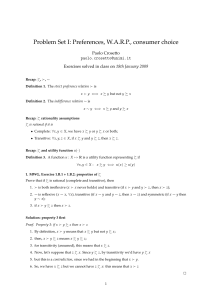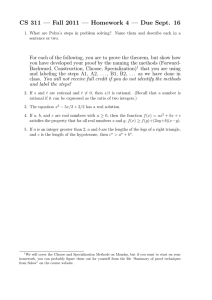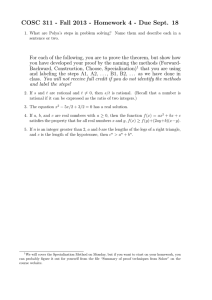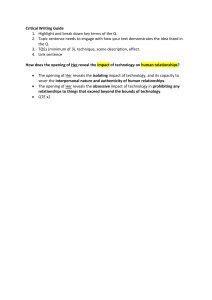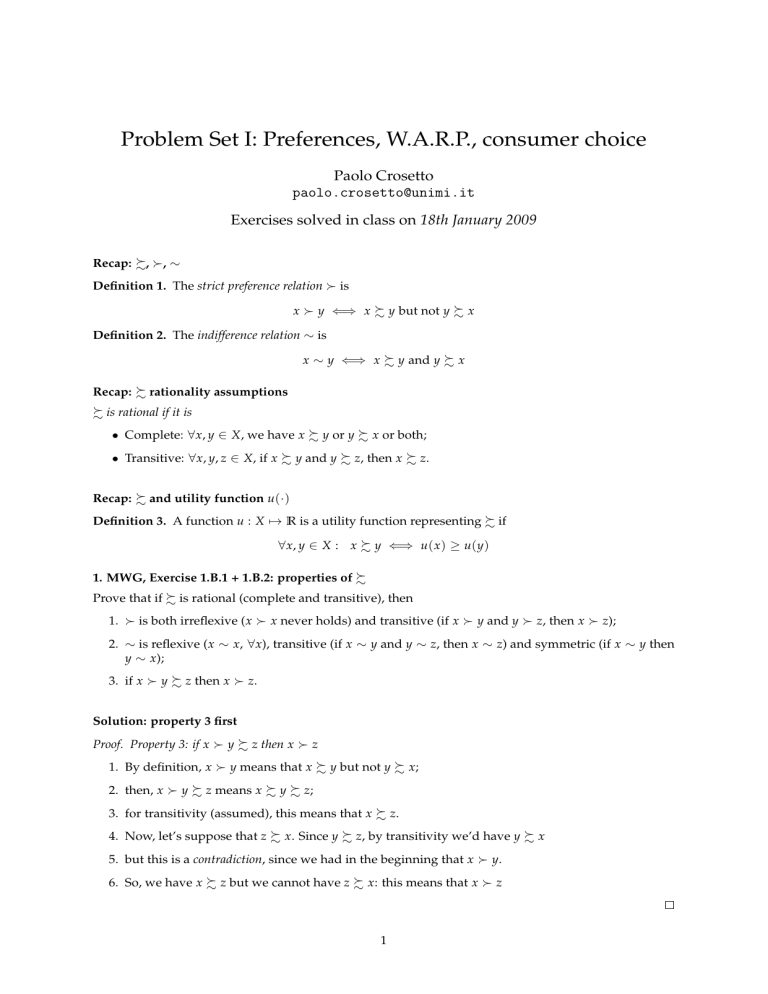
Problem Set I: Preferences, W.A.R.P., consumer choice
Paolo Crosetto
paolo.crosetto@unimi.it
Exercises solved in class on 18th January 2009
Recap: %, , ∼
Definition 1. The strict preference relation is
x y ⇐⇒ x % y but not y % x
Definition 2. The indifference relation ∼ is
x ∼ y ⇐⇒ x % y and y % x
Recap: % rationality assumptions
% is rational if it is
• Complete: ∀ x, y ∈ X, we have x % y or y % x or both;
• Transitive: ∀ x, y, z ∈ X, if x % y and y % z, then x % z.
Recap: % and utility function u(·)
Definition 3. A function u : X 7→ R is a utility function representing % if
∀ x, y ∈ X : x % y ⇐⇒ u( x ) ≥ u(y)
1. MWG, Exercise 1.B.1 + 1.B.2: properties of %
Prove that if % is rational (complete and transitive), then
1. is both irreflexive (x x never holds) and transitive (if x y and y z, then x z);
2. ∼ is reflexive (x ∼ x, ∀ x), transitive (if x ∼ y and y ∼ z, then x ∼ z) and symmetric (if x ∼ y then
y ∼ x);
3. if x y % z then x z.
Solution: property 3 first
Proof. Property 3: if x y % z then x z
1. By definition, x y means that x % y but not y % x;
2. then, x y % z means x % y % z;
3. for transitivity (assumed), this means that x % z.
4. Now, let’s suppose that z % x. Since y % z, by transitivity we’d have y % x
5. but this is a contradiction, since we had in the beginning that x y.
6. So, we have x % z but we cannot have z % x: this means that x z
1
Solution: property 1
Proof. Property 1: is irreflexive and transitive
1. Irreflexivity. Use completeness: x % y, ∀ x, y ∈ X:
2. hence, it must hold also for x % x, ∀ x ∈ X;
3. this means that in no case there can be x x.
4. Transitivity. Suppose x y and y z:
5. this means that at least x y % z.
6. But we have proved before that this means x z.
Solution: property 2
Proof. Property 2: ∼ is reflexive, transitive and symmetric
1. Reflexivity. By completeness, x % x, ∀ x ∈ X:
2. this implies also that x ∼ x, ∀ x ∈ X, by definition of ∼.
3. Transitivity. Suppose x ∼ y and y ∼ z:
4. by the definition of ∼, this means that all of these hold:
5. x % y, y % x, y % z, z % y.
6. By transitivity of %, this implies both x % z and z % x: hence x ∼ z.
7. Symmetry. Suppose x ∼ y: by definition, then x % y and y % x.
8. But the latter is also the definition of y ∼ x, if you look it the other way around.
9. hence, x ∼ y implies y ∼ x.
2. MWG 1.B.3 + 1.B.4.: % and u(·)
• Show that if f : R 7→ R is a strictly increasing function and u : X 7→ R is a utility function
representing the preference relation %, then the function v : X 7→ R defined by v( x ) = f (u( x )) is
also a utility function representing %;
• Consider a preference relation % and a function u : X 7→ R. Show that if u( x ) = u(y) implies
x ∼ y and if u( x ) > u(y) implies x y then u(·) is a utility function representing %.
Solution: strictly increasing function, intuition
• We will prove that a utility function associated with % is ordinal and not cardinal in nature.
• This is important: among other things, it implies that it is impossible to make interpersonal utility
comparisons directly.
• Note the definition of strictly increasing function:
Definition 4. A function f ( x ) is said to be strictly increasing over an interval I if f (b) > f ( a) for all
b > a, when a, b ∈ I.
Example 5. Functions that are strictly increasing over their whole domain are among others all positive
straight lines (y = ax, a > 0) and positive exponentials (y = a x , a > 0); other functions can be increasing
over a part of their domain, as parabola (y = x2 , for x > 0).
• Tip: a strictly increasing function on interval I has its derivative positive on I.
2
Solution: strictly increasing functions, plots
Solution: strictly increasing function, proof
Proof. A strictly increasing transformation of a utility function is still a utility function
1. Let’s take x, y ∈ X. Since u(·) represents %, by definition:
2. if x % y then u( x ) ≥ u(y).
3. since f (·) is strictly increasing, applying f (·) to u(·) does not change order, but only magnitude;
4. hence, f (u( x )) ≥ f (u(y)), i.e. v( x ) ≥ v(y) when x % y:
5. hence, v(·) is a utility function representing %.
Solution: u(·), and ∼.
Proof. if x % y, then u( x ) ≥ u(y)
1. Suppose x % y.
2. if at this we add y % x, then x ∼ y and u( x ) = u(y).
3. if instead we don’t have y % x, then x y and u( x ) > u(y).
4. hence, if x % y, then u( x ) ≥ u(y)
Proof. if u( x ) ≥ u(y), then x % y
1. Suppose u( x ) ≥ u(y).
2. if at this we add u( x ) = u(y), then x ∼ y.
3. if instead we add u( x ) > u(y), then x y.
4. hence, if u( x ) ≥ u(y), then x % y.
3
3. MWG 1.B.5: % and u(·), II
Show that if X is finite and % is a rational preference relation on X, then there is a utility function
u : X 7→ R that represents %.
Solution: intuition
• Since X is finite, the set of pairwise combination of elements of X is finite too;
• Since % is rational (hence complete and transitive):
– it defines a preference over all of the finite set of pairs;
– it excludes contradictory cycles of preferences.
• Hence, intuitively it is possible to rank all x, y ∈ X according to %;
• it must then be possible to build a utility function with such a complete ranking using ≥.
Solution: proving by induction
• A proof by induction is done by showing that something is true for n = 1 and then for n + 1;
• it then follows that it must be true for all n up to N.
• Proof by induction is used in the set of natural numbers N.
• More formally, for any proposition P(n) about positive integers:
• Prove that P(1) is true (base case);
• Prove that for each k ≥ 1, if P(k) is true, then P(k + 1) is true (inductive step).
Example 6. Consider a set of domino tiles. If domino tile n falls, tile n + 1 will fall. If we prove that tile
1 has fallen, then we can conclude that all tiles will fall.
Solution: proof, x y
Proof. if X is finite, then there exists a u(·) representing %: no indifference
1. Start considering that no two items are indifferent, i.e. x y, ∀ x, y ∈ X;
2. Let’s prove by induction that in such a setting there exists a u(·) representing %.
3. Base case: if N = 1 there is nothing to prove.
4. Inductive step: Let’s suppose the claim is true for N − 1, and let’s prove it is still ture for N.
1. Let’s take X = { x1 , x2 , . . . , x N −1 , x N }.
2. By hypothesis, there exists a u(·) on % defined up to x N −1 .
3. Let’s order the x: let’s assume u( x1 ) > u( x2 ) > · · · > u( x N −1 ).
4. Since we have assumed no indifference, the above ranking means exclusively:
∀i < N, x N xi
∀i < N, xi x N
∃i < N and j < N s.t. xi x N x j
4
Solution: proof, x y continued
Proof. ...continued
In all the three cases above we can find a value of u(·) that is consistent:
1. In Case 1, we can take u( N ) > u( x1 );
2. In Case 2, we can take u( N ) < u( x N − 1);
3. in Case 3:
• Define two intervals I = {i ∈ (1 . . . N ) : xi x N } and J = { j ∈ (1 . . . N ) : x N x j };
• I and J are disjoint intervals on N by our hypotheses;
• then if i∗ = max I, i∗ + 1 = min J.
• We can then take u( x N ) to lie in the interval (u(i∗ ), u(i∗ + 1)).
Hence, in all of three cases an utility function can be built.
Recap: W.A.R.P., %∗
Definition 7 (WARP). A choice structure (B , C (·)) satisfies the weak axiom if for some B ∈ B with
x, y ∈ B we have x ∈ C ( B), then for any B0 ∈ B with x, y ∈ B0 , if we have y ∈ C ( B0 ) we must also have
x ∈ C ( B0 )
• Which is indeed a minimal consistency requirement. Note that completeness and transitivity are
not required.
Definition 8 (Revealed preference relation %∗ ). Given a choice structure (B , C (·)), the revealed preference relation %∗ is defined as:
x %∗ y ⇐⇒ there is some B ∈ B such that x, y ∈ B and x ∈ C ( B).
• Which is just ’attaching a preference relationship’ to choices
• Note again that nor completeness nor transitivity are implied. It is just descriptive.
Recap: Rationalizability
Rational preferences %
⇒
W.A.R.P. satisfied
X always
W.A.R.P. satisfied
⇒
Rational preferences %
× not always
Definition 9 (Rationalizability). Given a choice structure (B , C (·)), the rational preference relation %
rationalizes C (·) relative to B if C ( B) = C ∗ ( B, %) for all B ∈ B . In other words, % generates the choice
structure (B , C (·)).
• the W.A.R.P. is a necessary but not sufficient condition for rationalizability.
• if B includes all subsets of X of up to three elements, then it is also sufficient:
• intuitively, the three-members property implies transitivity...
4. Exercise on W.A.R.P.
Consider a choice problem with choice set X = { x, y, z}. Consider the following choice structures:
• (B 0 , C (·)), in which B 0 = {{ x, y}, {y, z}, { x, z}, { x }, {y}, {z}} and C ({ x, y}) = { x }, C ({y, z}) =
{y}, C ({ x, z}) = {z}, C ({ x }) = { x }, C ({y}) = {y}, C ({z}) = {z}.
• (B 00 , C (·)), in which B 00 = {{ x, y, z}, { x, y}, {y, z}, { x, z}, { x }, {y}, {z}} and C ({ x, y, z}) = { x },
C ({ x, y}) = { x }, C ({y, z}) = {z}, C ({ x, z}) = {z}, C ({ x }) = { x }, C ({y}) = {y}, C ({z}) =
{ z }.
5
• (B 000 , C (·)), in which B 000 = {{ x, y, z}, { x, y}, {y, z}, { x, z}, { x }, {y}, {z}} and C ({ x, y, z}) = { x },
C ({ x, y}) = { x }, C ({y, z}) = {y}, C ({ x, z}) = { x }, C ({ x }) = { x }, C ({y}) = {y}, C ({z}) =
{ z }.
For every choice structure say if the WARP is satisfied and if it exists a rational preference relation %
that rationalizes C (·) relative to its B . If such a rationalization is possible, write it down. Comment on
your results.
Solution: (B 0 , C (·))
The choice structure can be summarised in these three relations:
• C ({ x, y}) = { x } reveals x %∗ y;
• C ({y, z}) = {y} reveals y %∗ z
• C ({ x, z}) = {z} reveals z %∗ x
1. W.A.R.P. is trivially satisfied
• the same couple never appears more than once in different budgets;
• moreover, B 0 does not include all budgets up to three elements.
• %∗ revealed preference relation is not necessarily transitive
2. B 0 is NOT rationalizable:
• C ({ x, y}) = { x } is rationalised by x y;
• C ({y, z}) = {y} is rationalised by y z;
• C ({ x, z}) = {z} is rationalised by z x.
• It is not transitive, hence (B 0 , C (·)) is not rationalisable.
Solution: (B 00 , C (·))
The choice structure can be summarised in these relations:
• C ({ x, y, z}) = { x } reveals x %∗ y and x %∗ z
• C ({ x, y}) = { x } reveals x %∗ y;
• C ({y, z}) = {y} reveals y %∗ z;
• C ({ x, z}) = {z} reveals z %∗ x.
1. W.A.R.P. is NOT satisfied
• x %∗ z and z %∗ x hold at the same time;
• in this case it exists x, z ∈ B : C ( B) = { x }, but there is also...
• ...a x, z ∈ B0 : z ∈ C ( B0 ) but not x ∈ C ( B0 )
2. B 00 is NOT rationalisable:
• since in general if % is rational ⇒ %∗ satisfies W.A.R.P.;
• then, by using the contrapositive, if A ⇒ B, it must be true that ¬ B ⇒ ¬ A
• Hence (B 00 , C (·)) is not rationalisable
6
Solution: (B 000 , C (·))
The choice structure can be summarised in these relations:
• C ({ x, y, z}) = { x } reveals x %∗ y and x %∗ z
• C ({ x, y}) = { x } reveals x %∗ y;
• C ({y, z}) = {y} reveals y %∗ z;
• C ({ x, z}) = { x } reveals x %∗ z.
1. W.A.R.P. is satisfied
• there are no violations of the type x %∗ y and y %∗ x;
• moreover, B 000 includes all budgets up to three elements.
2. B 000 is rationalizable:
• C ({ x, y, z}) = { x } reveals x y and x z
• C ({ x, y}) = { x } reveals x y;
• C ({y, z}) = {y} reveals y z;
• C ({ x, z}) = { x } reveals x z.
• Hence x y z is complete and transitive and rationalises (B 000 , C (·))
5. MWG 1.D.2: % and W.A.R.P.
Show that if X is finite, then any rational preference relation generates a nonempty choice rule; that is,
C ( B) 6= ∅ for any B ⊂ X with B 6= ∅.
Solution
Proof. X finite ⇒ C ( B) 6= ∅
1. We proved earlier that if X is finite, then u(·) is a utility function representing a rational %. (by
induction. Remember??)
2. Since X is finite, for any B ⊂ X with B 6= ∅ there exists x ∈ C ( B) such that u( x ) ≥ u(y) for all
y ∈ B...
3. ...remember that finiteness implied that we could order all alternatives in X, and assign a value.
4. Then, it means that x ∈ C ∗ ( B, %), i.e. x is chosen according to preference relation in B.
5. Hence, C ∗ ( B, %) cannot be empty: C ∗ ( B, %) 6= ∅
7
